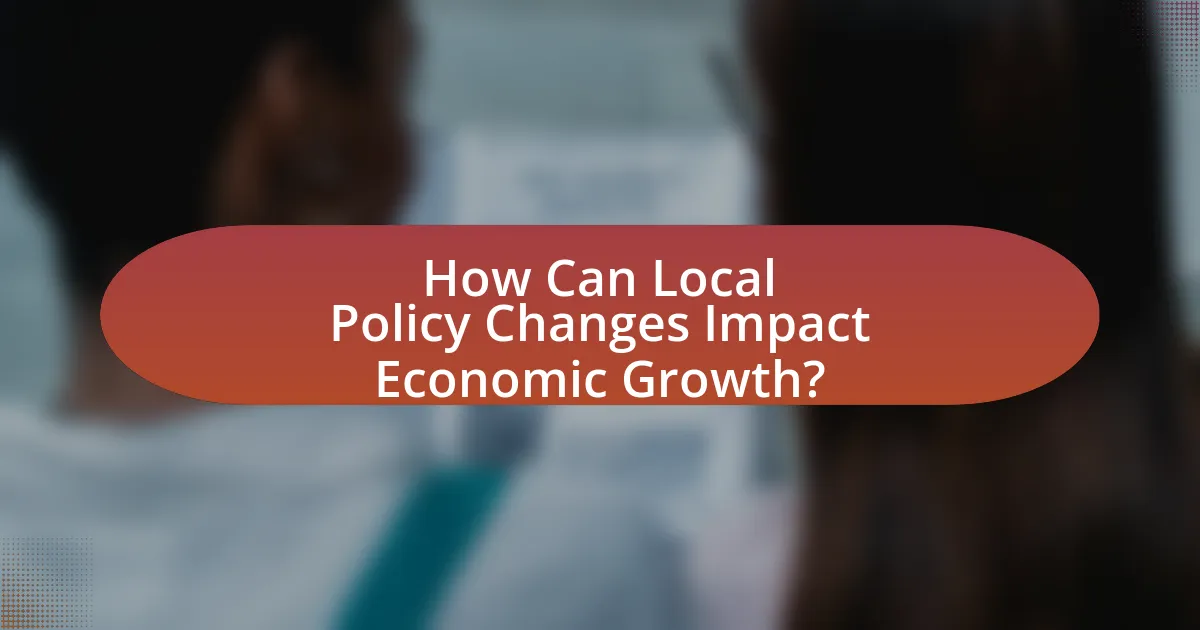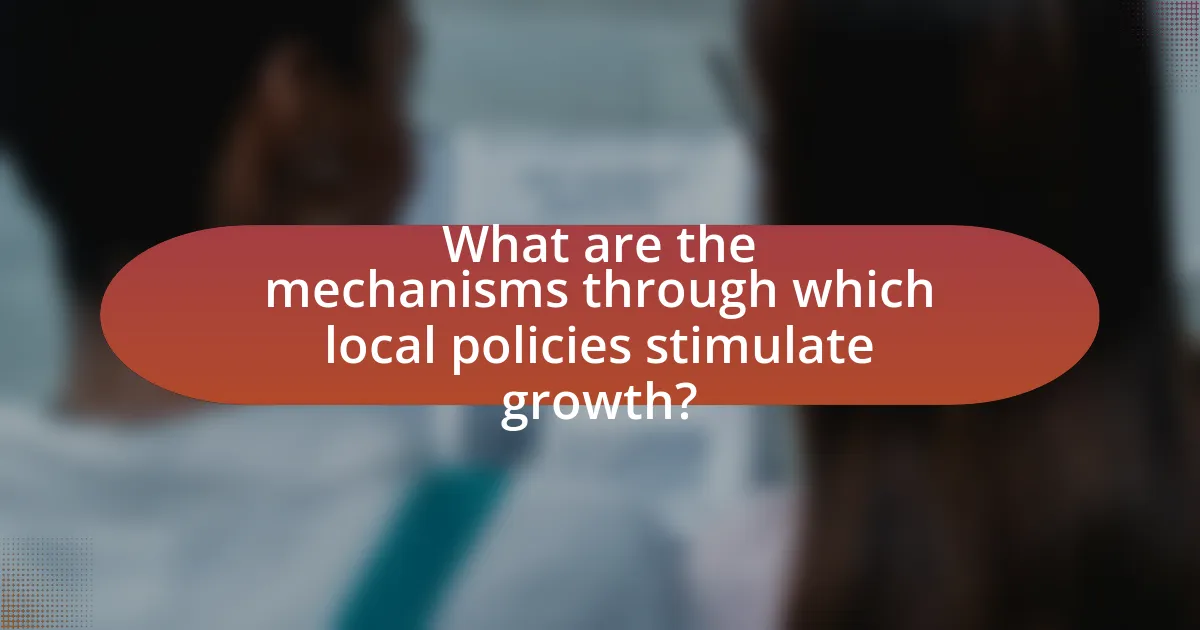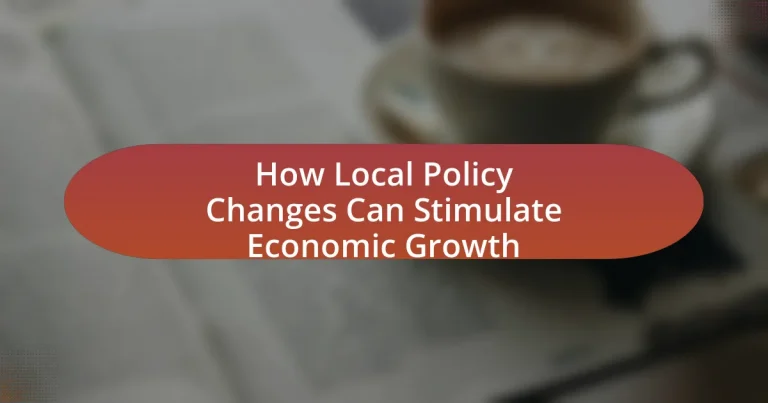Local policy changes play a crucial role in stimulating economic growth by shaping business environments, investment levels, and workforce development. Key strategies include tax incentives, zoning reforms, and infrastructure investments, which collectively enhance productivity and attract businesses. Effective local governance is essential for implementing these policies, as it allows for tailored approaches that address community needs. However, challenges such as limited resources and public resistance can hinder policy changes. The article also explores the impact of local policies on job creation, income inequality, and innovation, highlighting the importance of community engagement and data-driven decision-making in fostering equitable economic development.

How Can Local Policy Changes Impact Economic Growth?
Local policy changes can significantly impact economic growth by influencing business environments, investment levels, and workforce development. For instance, tax incentives for businesses can attract new companies and encourage existing ones to expand, leading to job creation and increased economic activity. A study by the National Bureau of Economic Research found that local tax incentives can lead to a 20% increase in business investment in targeted areas. Additionally, policies that improve infrastructure, such as transportation and communication systems, enhance productivity and efficiency, further stimulating economic growth. Therefore, effective local policy changes can create a favorable climate for economic development, driving growth through increased investment and improved operational conditions for businesses.
What types of local policy changes are most effective?
Local policy changes that are most effective in stimulating economic growth include tax incentives, zoning reforms, and investment in infrastructure. Tax incentives, such as property tax abatements or sales tax exemptions, encourage businesses to invest and expand in a locality, leading to job creation and increased economic activity. Zoning reforms that allow for mixed-use developments can attract diverse businesses and residents, enhancing community vibrancy and economic resilience. Investment in infrastructure, such as transportation and broadband, improves connectivity and accessibility, which are critical for attracting and retaining businesses. Studies have shown that cities implementing these types of policies experience higher rates of economic growth and improved quality of life for residents. For example, a report by the Brookings Institution highlights that cities with strategic tax incentives saw a 20% increase in business investments over five years.
How do tax incentives influence business development?
Tax incentives significantly influence business development by reducing operational costs and encouraging investment. These incentives, such as tax credits or deductions, directly lower the financial burden on businesses, making it more feasible for them to expand operations, hire employees, and invest in new technologies. For instance, a study by the National Bureau of Economic Research found that states offering tax incentives experienced a 20% increase in business investment compared to those that did not. This correlation demonstrates that tax incentives can effectively stimulate economic growth by fostering a more favorable environment for business activities.
What role do zoning laws play in economic expansion?
Zoning laws significantly influence economic expansion by regulating land use and development patterns. These laws determine where businesses can operate, which directly affects local economic activity and investment. For instance, by designating specific areas for commercial, industrial, or residential use, zoning laws can attract businesses to certain locations, fostering job creation and economic growth. A study by the Lincoln Institute of Land Policy found that cities with flexible zoning regulations experienced higher rates of economic development compared to those with rigid zoning frameworks. This demonstrates that well-structured zoning laws can facilitate economic expansion by promoting efficient land use and encouraging investment in targeted areas.
Why is local governance crucial for economic strategies?
Local governance is crucial for economic strategies because it enables tailored policy-making that directly addresses the unique needs and challenges of local communities. Effective local governance allows for the implementation of targeted economic initiatives, such as infrastructure development, workforce training programs, and local business support, which can stimulate job creation and enhance economic resilience. For instance, a study by the World Bank highlights that decentralized governance structures can lead to improved public service delivery and increased local investment, ultimately fostering economic growth.
How does local leadership affect policy implementation?
Local leadership significantly influences policy implementation by shaping priorities, mobilizing resources, and fostering community engagement. Effective local leaders can align policy objectives with community needs, ensuring that initiatives are relevant and supported. For instance, a study by the National League of Cities found that cities with strong local leadership are more likely to successfully implement economic development policies, as these leaders can effectively communicate the benefits and rally public support. This connection between leadership and successful policy execution is critical for stimulating economic growth at the local level.
What are the challenges local governments face in policy changes?
Local governments face several challenges in implementing policy changes, primarily including limited financial resources, bureaucratic inertia, and public resistance. Limited financial resources restrict the ability of local governments to fund new initiatives or adapt existing policies, often leading to prioritization issues. Bureaucratic inertia refers to the resistance within government structures to change established processes, which can slow down the implementation of new policies. Public resistance arises when constituents oppose changes due to concerns about their impact, leading to challenges in gaining necessary support for policy shifts. These factors collectively hinder the effectiveness and timeliness of local policy changes aimed at stimulating economic growth.
How do community engagement and public input shape policies?
Community engagement and public input shape policies by ensuring that the voices and needs of the community are reflected in decision-making processes. This participatory approach allows policymakers to gather diverse perspectives, which can lead to more effective and relevant policies. For instance, research by the International Association for Public Participation indicates that when communities are involved in the policy-making process, the resulting policies are more likely to address local issues and gain public support, ultimately enhancing their implementation and effectiveness.
What methods can be used to gather community feedback?
Surveys and questionnaires are effective methods to gather community feedback. These tools allow for the collection of quantitative data from a large number of respondents, enabling policymakers to gauge public opinion on local policy changes. According to a study by the Pew Research Center, 68% of Americans prefer to provide feedback through online surveys, highlighting their popularity and effectiveness in reaching diverse community members. Additionally, focus groups facilitate in-depth discussions, providing qualitative insights into community sentiments and concerns. This method allows for a deeper understanding of the motivations behind community feedback, as evidenced by research from the International Association for Public Participation, which emphasizes the value of direct dialogue in shaping effective policies.
How does public participation enhance policy effectiveness?
Public participation enhances policy effectiveness by ensuring that policies are more reflective of the needs and preferences of the community. When citizens engage in the policymaking process, they provide valuable insights and local knowledge that can lead to more informed decisions. Research indicates that policies developed with public input are more likely to gain community support and compliance, which is crucial for successful implementation. For instance, a study by the International Association for Public Participation found that public involvement can increase the likelihood of policy success by up to 50%, as it fosters trust and collaboration between policymakers and the community.

What are the mechanisms through which local policies stimulate growth?
Local policies stimulate growth through mechanisms such as targeted investment in infrastructure, tax incentives, and workforce development programs. Targeted investment in infrastructure, such as transportation and utilities, enhances connectivity and accessibility, which can attract businesses and improve local economies. Tax incentives, including reductions or exemptions, encourage business expansion and new investments, leading to job creation and increased economic activity. Workforce development programs focus on skill enhancement and training, aligning local labor with industry needs, thereby increasing productivity and competitiveness. These mechanisms collectively contribute to a more favorable business environment, fostering sustainable economic growth.
How do local policies attract investment?
Local policies attract investment by creating a favorable business environment through incentives, regulatory frameworks, and infrastructure development. For instance, tax breaks and grants can lower operational costs for businesses, making a region more appealing for investment. Additionally, streamlined permitting processes reduce bureaucratic hurdles, encouraging companies to establish operations quickly. According to a report by the Brookings Institution, regions that implement targeted economic development strategies, such as workforce training programs and improved transportation networks, see a significant increase in private sector investment. These policies not only enhance the attractiveness of a locality but also foster long-term economic growth by building a skilled workforce and improving overall quality of life.
What incentives can local governments offer to businesses?
Local governments can offer various incentives to businesses, including tax breaks, grants, and subsidies. Tax breaks can reduce the financial burden on businesses, encouraging investment and expansion; for example, many local governments provide property tax abatements to attract new companies. Grants can support specific projects or initiatives, such as workforce training or infrastructure improvements, which enhance business operations. Subsidies may be offered to lower operational costs, making it more feasible for businesses to hire employees or invest in new technologies. These incentives are designed to stimulate economic growth by fostering a favorable business environment, ultimately leading to job creation and increased local revenue.
How does infrastructure development support economic growth?
Infrastructure development supports economic growth by enhancing connectivity, reducing transportation costs, and improving access to services. For instance, investments in roads, bridges, and public transit systems facilitate the movement of goods and people, which can lead to increased productivity and efficiency in various sectors. According to the World Bank, every 1% increase in infrastructure investment can lead to a 1.5% increase in GDP growth in developing countries. This correlation demonstrates that robust infrastructure not only attracts businesses but also fosters job creation and stimulates local economies.
What impact do local policies have on job creation?
Local policies significantly influence job creation by shaping the economic environment in which businesses operate. For instance, policies that provide tax incentives or grants to businesses can encourage investment and expansion, leading to increased hiring. A study by the National Bureau of Economic Research found that local tax incentives can lead to a 10% increase in job creation in targeted industries. Additionally, policies that support workforce development, such as training programs and education initiatives, enhance the skill set of the local labor force, making it more attractive for employers to hire locally. This correlation between supportive local policies and job creation underscores the critical role that local governance plays in economic growth.
How do workforce development programs contribute to economic growth?
Workforce development programs contribute to economic growth by enhancing the skills and employability of the labor force, which leads to increased productivity and innovation. These programs provide training and education that align with the needs of local industries, ensuring that workers possess the relevant skills required for available jobs. For instance, a report from the National Skills Coalition indicates that every dollar invested in workforce development can yield a return of up to $4.50 in economic benefits, demonstrating a clear link between skill enhancement and economic performance. Additionally, regions with robust workforce development initiatives often experience lower unemployment rates and higher wages, further stimulating local economies.
What is the relationship between local policies and unemployment rates?
Local policies significantly influence unemployment rates by shaping the economic environment and labor market conditions. For instance, policies that promote business development, such as tax incentives or streamlined regulations, can attract new companies and stimulate job creation, thereby reducing unemployment. A study by the National Bureau of Economic Research found that local governments that implemented business-friendly policies experienced a 10% decrease in unemployment rates over five years. Conversely, restrictive policies can hinder economic growth and lead to higher unemployment. Thus, the relationship between local policies and unemployment rates is direct and impactful, with evidence supporting that effective local governance can lead to improved employment outcomes.
How can local policies foster innovation and entrepreneurship?
Local policies can foster innovation and entrepreneurship by creating supportive ecosystems that provide resources, funding, and infrastructure. For instance, policies that offer tax incentives for startups can lower financial barriers, encouraging new business formation. Additionally, local governments can establish innovation hubs or incubators that facilitate networking and collaboration among entrepreneurs, which has been shown to enhance creativity and idea generation. Research from the Kauffman Foundation indicates that regions with strong local support systems for entrepreneurs experience higher rates of business creation and growth, demonstrating the effectiveness of such policies in stimulating economic activity.
What support systems are essential for startups in local economies?
Essential support systems for startups in local economies include access to funding, mentorship programs, networking opportunities, and business development resources. Access to funding is critical, as startups often require capital to launch and scale; for instance, local venture capital firms and angel investors can provide necessary financial backing. Mentorship programs connect new entrepreneurs with experienced business leaders, facilitating knowledge transfer and guidance, which is vital for navigating challenges. Networking opportunities, such as local business events and incubators, foster collaboration and partnerships, enhancing the startup ecosystem. Additionally, business development resources, including training workshops and access to market research, equip startups with the skills and information needed to succeed. These support systems collectively contribute to a thriving local economy by promoting innovation and job creation.
How do local policies encourage research and development?
Local policies encourage research and development by providing financial incentives, regulatory support, and fostering collaboration between public and private sectors. For instance, tax credits and grants can significantly reduce the financial burden on companies investing in R&D, as seen in regions like Silicon Valley, where local governments offer substantial tax breaks to tech firms. Additionally, streamlined regulations can facilitate quicker project approvals, allowing for faster innovation cycles. Collaborative initiatives, such as public-private partnerships, enhance resource sharing and knowledge transfer, exemplified by local universities partnering with businesses to drive technological advancements. These strategies collectively create an environment conducive to innovation and economic growth.

What are the potential drawbacks of local policy changes?
Local policy changes can lead to unintended consequences that may hinder economic growth. These drawbacks include potential disruptions to existing businesses, as sudden regulatory shifts can create uncertainty and increase operational costs. For instance, a study by the National Bureau of Economic Research found that abrupt policy changes can lead to a 20% increase in compliance costs for small businesses, which may deter investment and innovation. Additionally, local policy changes can exacerbate inequalities if benefits are not evenly distributed, potentially alienating certain community groups and leading to social unrest.
What risks are associated with rapid policy changes?
Rapid policy changes can lead to significant risks, including instability in economic environments, confusion among stakeholders, and unintended consequences. For instance, abrupt shifts in regulations can disrupt existing business operations, leading to financial losses and reduced investor confidence. Historical examples, such as the rapid deregulation of the banking sector in the late 1990s, illustrate how swift policy changes can contribute to economic crises, as seen in the 2008 financial meltdown. Additionally, stakeholders may struggle to adapt to new policies, resulting in compliance issues and potential legal challenges. These factors collectively highlight the importance of carefully considering the implications of rapid policy changes on economic growth and stability.
How can unintended consequences arise from new policies?
Unintended consequences can arise from new policies when the outcomes differ from the intended goals due to complex interactions within the economic and social systems. For instance, a policy aimed at stimulating local business growth might inadvertently lead to increased competition that drives smaller businesses out of the market, resulting in job losses rather than job creation. Historical examples include the introduction of minimum wage laws, which, while intended to increase worker income, can lead to higher unemployment rates among low-skilled workers as businesses adjust to increased labor costs. This demonstrates that the multifaceted nature of economic systems can produce results that policymakers did not foresee, highlighting the importance of thorough impact assessments before implementing new policies.
What measures can mitigate negative impacts on local communities?
Implementing community engagement initiatives can mitigate negative impacts on local communities. These initiatives foster collaboration between local governments, businesses, and residents, ensuring that development projects consider community needs and concerns. For instance, studies show that participatory planning processes lead to better project outcomes and increased community satisfaction, as evidenced by the successful implementation of community-led development in cities like Portland, Oregon, where local input significantly shaped urban policies. Additionally, providing economic support programs, such as job training and small business grants, can help offset potential job losses or economic disruptions caused by policy changes, thereby promoting resilience within the community.
How do local policies affect income inequality?
Local policies significantly influence income inequality by shaping economic opportunities, access to resources, and social services. For instance, policies that promote affordable housing can reduce the wealth gap by enabling lower-income families to live in areas with better job prospects and educational facilities. Research from the National Bureau of Economic Research indicates that cities with inclusive zoning laws experience less income inequality, as these laws facilitate diverse housing options and economic integration. Additionally, local tax policies that favor low-income households can enhance disposable income, thereby reducing inequality. Thus, the design and implementation of local policies play a crucial role in either mitigating or exacerbating income disparities within communities.
What strategies can address disparities caused by policy changes?
Strategies to address disparities caused by policy changes include implementing targeted economic assistance programs, enhancing access to education and job training, and fostering community engagement in policy development. Targeted economic assistance programs, such as tax credits or direct financial support, can help low-income individuals and families recover from adverse effects of policy changes. For instance, the Earned Income Tax Credit has been shown to reduce poverty and improve economic stability for working families. Enhancing access to education and job training equips individuals with skills necessary for higher-paying jobs, thereby reducing income inequality. Research indicates that areas with robust vocational training programs see increased employment rates and economic mobility. Lastly, fostering community engagement ensures that the voices of affected populations are heard in the policymaking process, leading to more equitable outcomes. Studies have demonstrated that inclusive policy development can lead to more effective and sustainable economic growth.
How can local governments ensure equitable growth?
Local governments can ensure equitable growth by implementing inclusive policies that prioritize access to resources and opportunities for all community members. This can be achieved through targeted investments in underserved areas, such as affordable housing, education, and healthcare, which have been shown to improve economic outcomes. For instance, a study by the Urban Institute found that equitable access to quality education significantly boosts long-term economic mobility. Additionally, local governments can engage in community-driven planning processes that involve residents in decision-making, ensuring that diverse voices are heard and considered in policy development. This approach not only fosters trust but also aligns growth initiatives with the actual needs of the community, leading to more sustainable and equitable economic development.
What lessons can be learned from past local policy changes?
Past local policy changes demonstrate that targeted interventions can effectively stimulate economic growth. For instance, cities that implemented tax incentives for small businesses, such as San Francisco’s 2014 Small Business Commission initiative, saw a 20% increase in new business registrations within a year. Additionally, policies promoting workforce development, like the Chicago Cook Workforce Partnership, resulted in a 15% increase in employment rates among participants. These examples illustrate that well-designed local policies can lead to measurable economic benefits, reinforcing the importance of data-driven decision-making in policy formulation.
What case studies illustrate successful local policy implementations?
Case studies illustrating successful local policy implementations include the city of Portland, Oregon, which adopted a comprehensive urban growth boundary policy that effectively curbed urban sprawl and promoted sustainable development. This policy led to a 30% increase in housing density and a significant reduction in greenhouse gas emissions, demonstrating the effectiveness of local governance in addressing environmental and economic challenges. Another example is the city of Chattanooga, Tennessee, which implemented a broadband initiative that provided high-speed internet access to underserved areas. This initiative resulted in a 20% increase in local business growth and attracted new tech companies, showcasing how targeted local policies can stimulate economic development and improve community connectivity.
How can failures inform future policy decisions?
Failures can inform future policy decisions by providing critical insights into what does not work, allowing policymakers to adjust strategies accordingly. Analyzing past failures, such as the 2008 financial crisis, reveals systemic weaknesses in regulatory frameworks that led to economic downturns. This analysis enables the development of more robust policies that address identified shortcomings, such as implementing stricter financial regulations to prevent similar crises. Additionally, case studies of failed local initiatives, like poorly executed urban renewal projects, highlight the importance of community engagement and data-driven decision-making, guiding future policies to be more inclusive and effective.
What best practices should local governments follow for effective policy changes?
Local governments should engage in stakeholder collaboration, data-driven decision-making, and transparent communication for effective policy changes. Stakeholder collaboration ensures that diverse perspectives are considered, which can lead to more comprehensive and accepted policies. Data-driven decision-making allows local governments to base their policies on empirical evidence, increasing the likelihood of successful outcomes. Transparent communication fosters trust and encourages public participation, which is essential for the implementation and sustainability of policy changes. For instance, cities that have adopted participatory budgeting processes have seen increased civic engagement and satisfaction, demonstrating the effectiveness of these best practices in stimulating economic growth.




